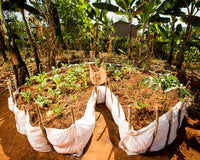Creating a biodiverse oasis is probably one of the most common dreams that we share in the gardening community. Each plant brings a unique aspect to our garden, and as exciting as it would be to have a little bit of everything, we know that plants serve unique purposes - for example, peppermint can deter pests, but it’s also an invasive species and can quickly grow and take over your garden if you aren’t careful.

To better understand your polli-neighbours, I would recommend learning more about their likes and dislikes. Gardening, like everything else, is about finding your balance. While rosemary will deter moths and mosquitoes, marigolds will encourage other varieties of pollinators to your garden. Find your balance and gain a deeper understanding of your wants and needs to build an ecosystem that works for you. As we know, it will only work to serve you in the long run! Happy planting, Kendall
As we learned in our last Beneficial Gardening blog, we want to take advantage of all the wonderful things biodiversity brings! Beyond the beauty of your foliage, you can also entice beneficial pollinators spreading life and love throughout your garden.
Why should I care about pollination?
It’s common knowledge that pollinators are strong contributors to a healthy ecosystem, garden, and yield; however not everyone understands why. It’s estimated that upwards of 95% of our crops rely on pollinators in order to flower. While this process can be done manually - which we will explore later on in this blog - it is extremely time consuming and, let’s be real here, an unreasonable expectation for us to even think about trying to fit into our limited spare time. Insects, spiders, birds, bats, all these creepy crawlies we don’t always love contribute to the widespread health and regulation of our environment.
Something incredible about pollinators is that they truly come in all different shapes, sizes, and species. Most people think of the typical bumble bee, but pollinators range between everything from bees to butterflies to hummingbirds to (my least favourite) spiders. If you’re an active member in the permaculture gardening community, you may have heard of Andrew Millison. He’s an extremely experienced permaculture instructor that reformed his home in Oregon into an incredible backyard self-sustaining oasis. He shared a video on Youtube showing the incredible work of ants pollinating his lemon tree. Yep, you read that right, ants!
Now, to understand how even the ant can act as a pollinator, we should get a deeper understanding of how pollination actually works. Naturally, the process works similarly to most living organisms where the pollen acts as a fertilizer to the budding flower. Many plants can flower/fruit without pollination, however the results will be much smaller and they will not produce seeds (the plant equivalent to an egg).
What are the different types of pollination?
There are two types of pollination: self pollination and cross pollination. Self pollination occurs within the same flower. The pollen is collected and transferred within the same flower, or a different flower within the same plant. Cross pollination is when the pollen from a separate flower is transferred to the female part of another flower of the same species.
But how does it really work?
So, the first thing you should know about all flowering plants is that there is an anther (male part) and the stigma (female part). Up close, pollen resembles bacteria where it is round and spiky, and can stick itself to the bodies of pollinators. The pollen sits on the anther of the flower and then travels to the stigma where the pollinators rub against it and voila, the flower is fertilized!

It’s actually so cool to see the circle of life happening in our own backyards! Bees rely on nectar out of flowers to create honey which sustains their lives. Maybe not even realizing that because of their actions, plants are able to be harvested and seeds are created from them meaning that we can continue to plant into future seasons. Helping sustain another generation of bees, while they work to maintain our gardens and ensure the most spectacular flowers.
Efforts are being made to preserve bee populations around the world today, and on a positive note, they are in a much better position now than they were even just a few years ago. Of course, we need to continue to keep them in our minds and hearts as we go forward. We need pollination to occur, our lives literally depend on it; though it is possible to pollinate by hand. As promised, let’s talk about what that really looks like.
To pollinate by hand, you need to follow these steps.
1. Find the stamen of the plant you’re working with
a. Often times this means that you need to actually remove the petals until you can see the anther
2. Using your finger (or a small tool such as a paint brush), gently touch the anther and move the pollen to the stigma
3. You will need to refresh often by going back and forth with each plant
Who pollinates?
I’m sure you can see now why this isn’t ideal. Imagine if we lived in a world without pollinators where we had to do this every day. It’s such a tedious task, but it’s a necessary part of survival that wildlife provides for us each and every day. Fortunately, there are so many different types of pollinators out there relieving us from this stress. Some of the most common pollinators are:
• Bees
• Moths
• Butterflies
• Hummingbirds
• Beetles
• Wasps
• Ants
• Flies
• Bats
• The list goes on and on!
What can I do to attract pollinators to my garden?





